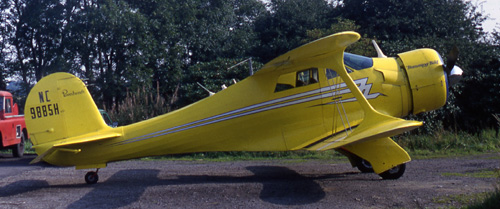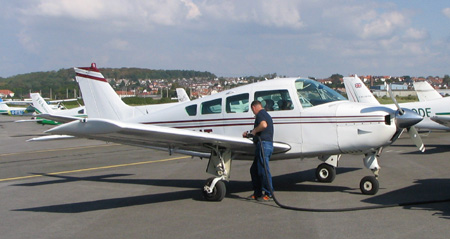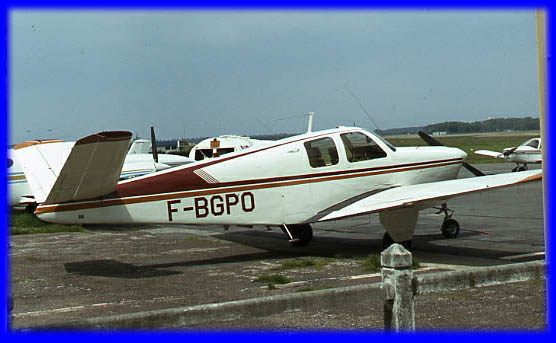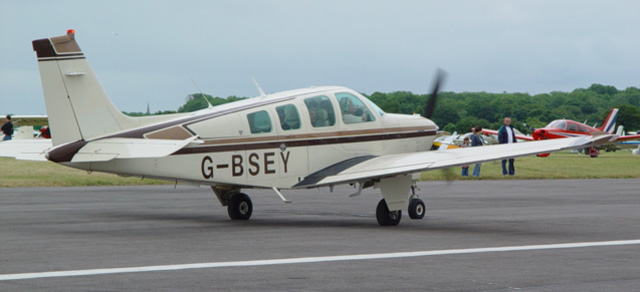|
| |
Back to Private
Aircraft
 |
The Beech 17 Staggerwing was the first design
by Walter Beech in the early 1930s, after he left the Travel Air
company where he was a partner with Clyde Cessna and Lloyd Stearman.
It is a fast, comfortable cabin biplane with four seats, initial
versions being powered by a 225hp Jacobs radial and later versions
having a massive 450hp Pratt & Whitney Wasp Junior. This plus
the retractable undercarriage (rare for the time) gives it a
cruising speed of over 210mph, quite something for a private
aeroplane of the time, and range of between 600 and 1,000 miles
depending on the version. It's pretty heavy, the more powerful
versions weighing in at around 4,200lb maximum weight. At 24 feet 5
inches long and
with a wing span of 32 feet, it always looks to me bigger than it
actually is. During the war, many were used by the US Army Air Force
as light liaison aircraft under the designation C-43 Traveller, and
by the US Navy as the GB. Many survive
as collectors items.
This one was at Barton in September 1979. |
 |
The Beech C23 Sundowner was one of three
models derived from the Beech Musketeer four seater of the early
1960s. It can be thought of as the Beech competitor to the Piper
Cherokee series. The Sundowner's 180hp Lycoming engine gives it a
cruising speed of 110mph and top speed of 135mph, with range of 700
miles. The original Musketeer first flew in October 1961; the C23
followed in 1965. 1,283 of the basic Musketeer were built, plus
1,107 as Sundowners, all with the Beech constructors prefix `M'; and
368 more designated A23-24, with prefix MA. Production ended in
1983.
Photograph by Ivy at Kemble in July 2005 |
 |
The Beech 24R Sierra is the ultimate
development of the Musketeer range, having originally been known as
the Musketeer Super R. The only model of the range with
a retractable undercarriage, it also has a constant speed propellor,
an optional fifth seat and a fourth side cabin window. Powered by a
200hp Lycoming engine, it may be considered as Beech's competitor to
the Piper Cherokee Arrow, though with a top speed of 160mph over a
range of 650 miles, the Sierra is a bit faster. Dimensions are the
same as the Sundowner: 25 feet 9 inches long, with a wing span of 32 feet
9 inches. Beech built 793 Sierras from 1969 to 1983, with the
manufacturer's prefix `MC'.
This one was at
Le Touquet, September 2005 |
|
|
The Beech 33 Debonair is a four seat tourer
which started life as a dumbed-down Bonanza (see below), with
conventional tail surfaces and a lower standard of interior finish
and avionics, yet with the same basic styling to appeal to pilots
wanting a higher standard of aeroplane. Generally powered by a 225hp
Continental engine, it has a top speed of 195mph and range of 1,070
miles. Gross weight is slightly less than the Bonanza, at 3,050 lb,
but other dimensions are similar: 25 feet 6 inches long, with a wing
span of 32 feet 10 inches. Some versions even used the Bonanza name.
It was produced from 1960 to 1994, during which a total of 3,274
were built, with Beech constructor's prefixes CD, CE and CJ covering
the various updates in that time. These
examples, with different rear window configurations, were both at
Toussus le Noble in July 1979. |
 |
The Beech 35 Bonanza is one of David's top
five favourite aircraft! The V tail is very distinctive and elegant.
The advantage is lower weight and less drag, at the expense of some
complexity in rigging and precision of slow speed handling. First
flown in December 1945, it set the standard for luxury light
aircraft for several decades, with 10,403 eventually being built by
the time production ended in 1982. As they
evolved, the engines grew increasingly powerful, from the initial
185 hp Continental up to 285hp in the later versions. Top speed is
over 210 mph. Early versions had a bizarre arrangement of control
wheel; there was only one, but it could be unlocked in flight and
swung over to the other pilot's seat - rather like the Heinkel He111
bomber! This is the aircraft I most aspire to own (a share of!) one
day. A four seater originally, later versions (S35 onwards) seat
six. Gross weight grew from 2,725 to 2,400lb over the various
versions, and range similarly grew from 500 to over 1,000 nautical
miles. It is 26 feet 5 inches long, with a wing span of 33 feet 6
inches. Beech type code is D. This very early A35 was at Toussus
le Noble in May 1983. |
 |
The Beech A36 Bonanza could be considered the
ultimate Bonanza development. It is a true six seater, powered by a
300hp Continental IO-550 engine, which gives it a cruising speed of
190mph and maximum range of over 1,000 miles. At 27 feet 6 inches,
it is slightly longer than the V-tail, but with the same wing. Gross
weight is 3,650lb. At Octoerb 2005 it is still in production, with
about 4,270 having been built since it was introduced in 1968 under
Beech type codes E and EA. It always gives the appearance of a
serious, professional machine. This one
was pictured by Ivy at Kemble in July 2005. |





|